Fancy yourself an adventurous eater? In almost every country you visit, you’ll come across a dish that will test how intrepid your taste buds really are. Sannakji in Korea and tamilok in Palawan are two that come to mind.
Deemed too extreme for foreigners not named Andrew Zimmern, they may even be too much for some locals so there’s no shame in chickening out! My sister-in-law is Korean and the thought of eating sannakji repulses even her. In short, they aren’t for everyone.
Satay is NOT one of those dishes.
Spelled sate in Indonesian and Malaysian but pronounced the same as the English “satay”, this skewered meat dish is almost impossible not to like (unless you’re a vegetarian or vegan). It’s one of the first dishes we look for on every return visit to either country.
Save This on Pinterest!
No time to read this chicken satay recipe now? Click on the save button and pin it for later!
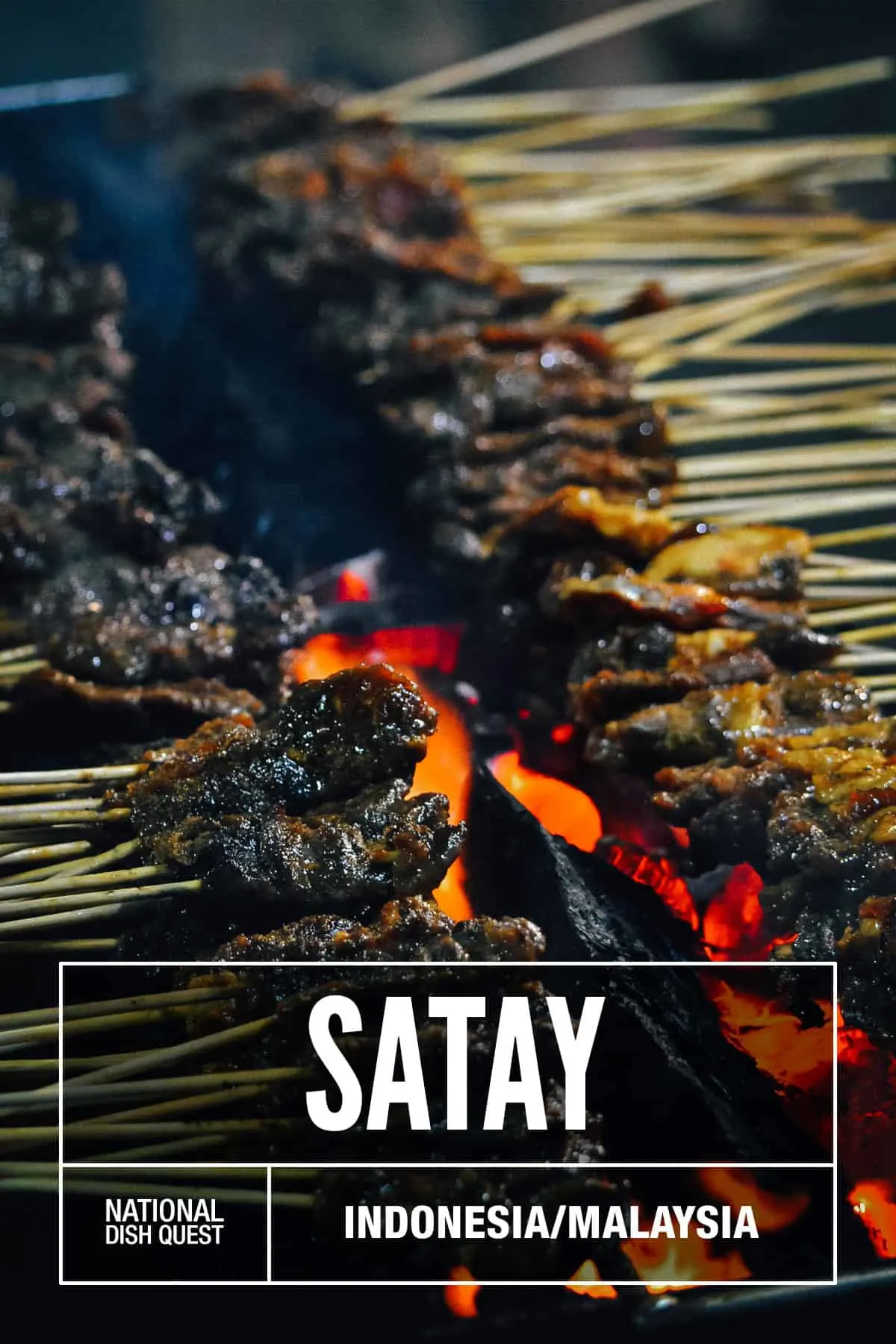
Photo by blazejosh via Pixabay
WHAT IS SATE/SATAY?
Satay is a seasoned and skewered meat dish that originated from the Indonesian island of Java. You can think of it as the Indonesian version of grilled meat skewers like Japanese kushiyaki/yakitori, Korean dakkochi, Georgian mtsvadi, or Armenian khorovats.
To prepare, different types of meat like chicken, lamb, fish, shrimp, and offal are marinated in turmeric and other ingredients before being grilled over charcoal. Depending on where it’s from and what it’s made with, satay can be served with different types of sauces like kecap manis (sweet soy sauce) or sambal, though the most common is a peanut dipping sauce (aka satay sauce).
The exact origins of satay are unclear though one common belief asserts that it was adapted from Indian kebabs that were introduced to Java by Muslim traders in the early 19th century. Since its invention, the dish has spread throughout the Malay Archipelago and has taken root in neighboring countries like Malaysia, Singapore, Brunei, Thailand, East Timor, and the Philippines. It’s even become a part of Dutch cuisine thanks to the shared colonial history between Indonesia and the Netherlands.
In Malaysia as in Indonesia, satay has become so popular that it’s now recognized as a national dish.
TYPES OF SATAY
Satay was originally made with grilled meats but these days, it can be prepared with anything – even non-meat ingredients like tofu and vegetables. Limited only by the imagination, you’ll find an almost limitless array of satay made from both common and exotic ingredients like liver, squid, tempeh, oyster mushrooms, crocodile, rabbit, and snails.
To whet your appetite and inspire you to cook satay, pictured in this section are some of the tasty sticks of satay we’ve enjoyed in Southeast Asia over the years, starting with these bouquets of beef and chicken satay waiting to be grilled at a streetside stall in Kuala Lumpur.

You can find similar dishes in almost every culture but one of the things I love most about this particular type of grilled skewered meat, apart from its flavor, is the size. They’re small, about three or four small chunks of meat per stick, so you can enjoy each stick in one mouthful. That allows us to order different kinds so we can try as many as we can in one sitting.
Here’s evidence of us overordering at a popular satay restaurant in Jakarta. As we learned that day, you CAN have too much of a good thing!
Satay sauce is usually served on the side but this restaurant drenches their lamb and chicken skewers in a sweet and spicy peanut sauce. The beef satay was served dry but it was enhanced with the aromatic flavor of toasted coconut. Delicicious!

These long charcoal grills are a common sight on the streets of Indonesia and Malaysia. A traditional satay grill is narrow and rectangular in shape and looks like a long loaf pan.
I can almost taste the smokiness of these beef and chicken satay skewers just from looking at this picture!

What you’re looking at below is a type of communal steamboat or hot pot called lok lok. Popular in Penang, I didn’t realize it at the time but lok lok is considered a type of satay as well.
It works like this – diners would sit around a table with a central pot of boiling water surrounded by skewered food ranging from seafood to meats and vegetables. Sticks are colored according to price and you grab whichever you want and dunk them into the pot to cook. Like kaitenzushi restaurants in Japan, it’s a fun dining experience that gives you full control over your meal.
Those three bowls on the right are the sauces. If I remember correctly, they had peanut sauce, sambal, and kecap manis.

Don’t eat meat? No worries. In a vegan-friendly destination like Ubud or Canggu in Bali, you won’t have any trouble finding plant-based versions of satay.
What you’re looking at here is a vegan version of sate taichan, a type of chicken satay served without satay sauce or kecap manis. Probably made with soy protein, this “chicken” satay was smothered in a supremely spicy but delicious sambal.
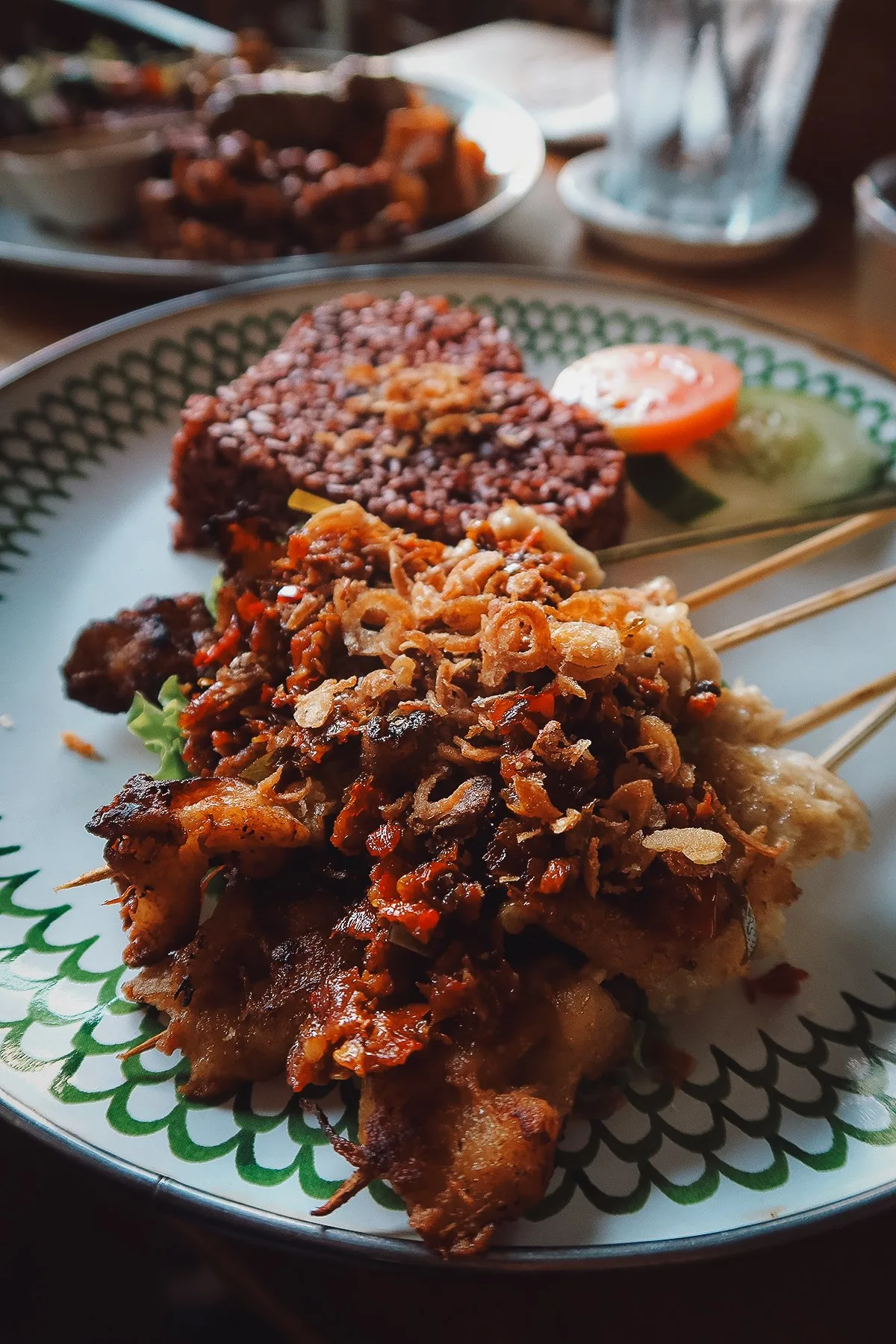
Aside from Indonesia and Malaysia, satay is common in Thailand and Singapore as well.
Thai chicken satay (pictured below) is pretty much the same as the Malaysian and Indonesian versions. Grilled chicken and peanut sauce go so well together so why change anything?
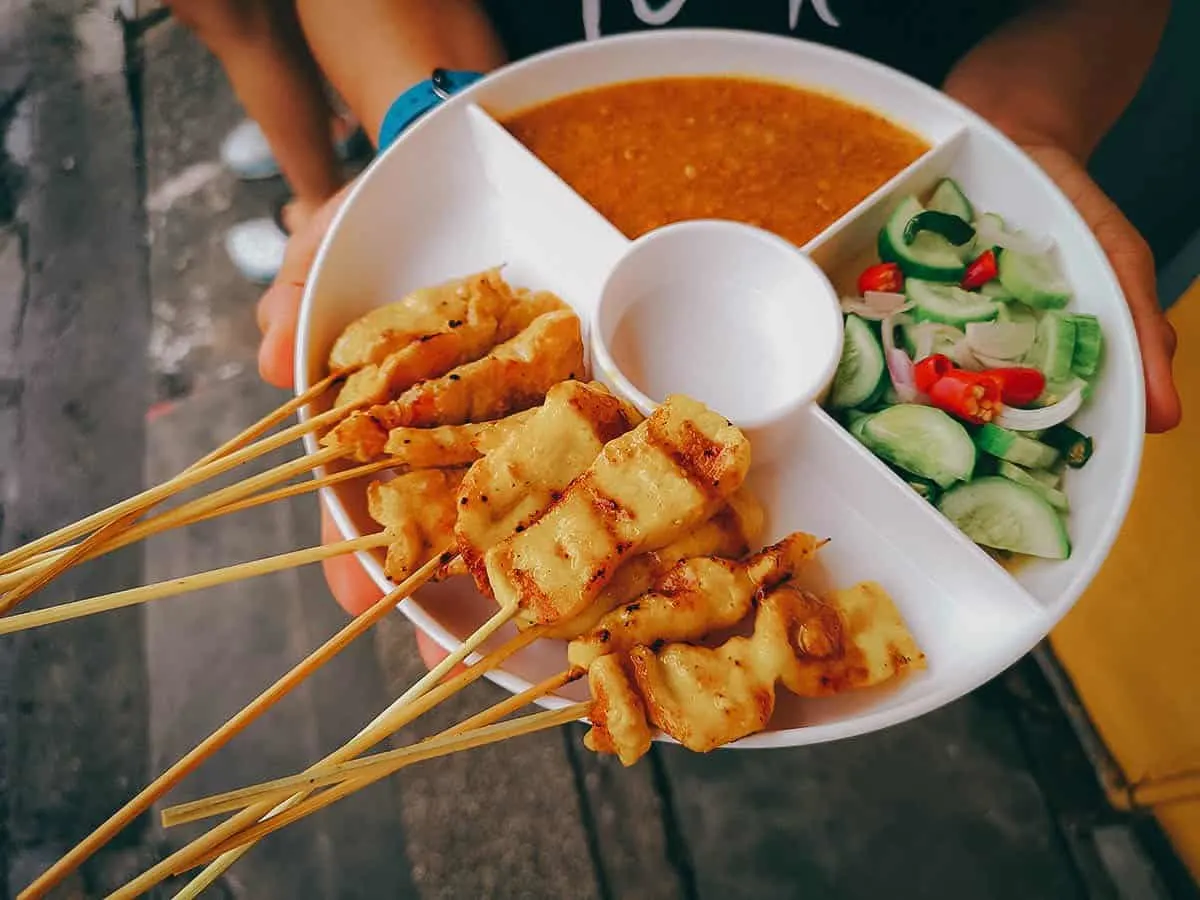

Chicken Satay With Peanut Sauce Recipe
A recipe for chicken satay, a national dish of Indonesia and Malaysia
Ingredients
For Chicken Satay
- 4 chicken thighs and legs (preferred) or 4 boneless and skinless chicken breasts
- Bamboo skewers (soaked in water for 2 hours to avoid burning)
For Satay Spice Paste (for chicken marinade)
- 1 tsp coriander powder
- 2 stalks lemongrass, white parts only
- 6 shallots, peeled
- 2 cloves garlic, peeled
- 4 Tbsps cooking oil
- 1 tsp chili powder
- 2 tsps turmeric powder
- 4 tsps of kecap manis (Indonesian sweet soy sauce)
- 1 tsp oyster sauce
- 1 cucumber, skin peeled and cut into small pieces
- 1 small onion, quartered
For Satay Peanut Sauce
- 1 1/2 cup dry roasted peanuts (unsalted)
- 1 cup water
- 1 Tbsp sweet soy sauce (kecap manis)
- 1 1/2 Tbsp sugar (palm sugar preferred)
- 1/8 tsp salt
- 1/4 cup oil
- 1 heaping Tbsp tamarind pulp (soaked in 1/4 cup water for 15 minutes, squeeze tamarind pulp for juice and discard pulp)
- Spice paste (see recipe below)
For Peanut Sauce Spice Paste
- 6-8 dried red chilies, seeded and soaked in warm water
- 3 cloves garlic
- 3 shallots
- 2 lemon grass (white parts only)
- 1 inch ginger (galangal preferred)
- 1 Tbsp coriander powder (optional)
Instructions
For Chicken Satay
- Cut the chicken meat into small cubes.
- Grind the spice paste ingredients in a food processor. Add in a little water if needed. Marinate the chicken pieces with the spice paste mixture for at least 12 hours (not to exceed 48 hrs).
- Thread the meat onto the bamboo skewers and grill for 2-3 minutes on each side. Serve hot with fresh cucumber slices and onions.
For Satay Peanut Sauce
- Crush the peanuts coarsely with a mortar and pestle or mini food processor then set aside.
- Chop the spice paste ingredients and blend until fine. Heat the oil and fry the spice paste mixture until it becomes aromatic. Add the peanuts, tamarind juice, water, sugar, and sweet soy sauce, and then stir thoroughly. Simmer over low heat and continue stirring for about 3 minutes until the peanut sauce becomes smooth. Serve at room temperature with the chicken satay.
FINAL THOUGHTS
And voila! Follow the chicken satay recipe above and this is what you’ll wind up with. Don’t you just love the grill marks on those chicken skewers?
Mrs Traveleater served these sticks of chicken satay with peanut sauce, steamed rice, and cucumber slices but on other occasions, she’s made them as part of a nasi lemak platter as well. I suggest trying that if you if you like the taste and aroma of coconut milk rice.
And feel free to experiment with the satay sauce. The recipe above is for a classic peanut dipping sauce but some recipes include other ingredients as well like fish sauce, lime juice, Thai red curry paste, and brown sugar, just to name a few. You’re encouraged to tweak the recipe based on your personal preference.
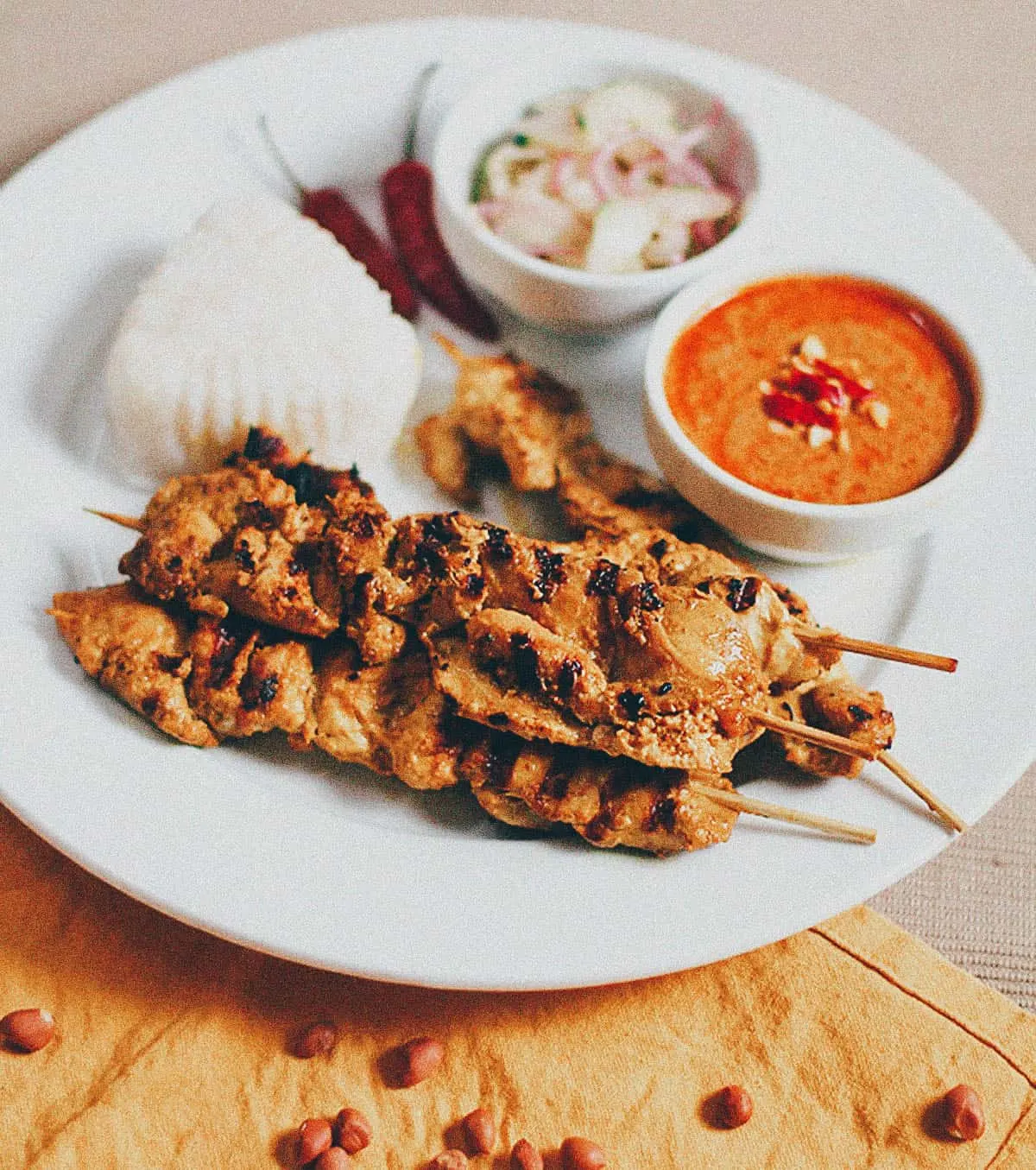
Speaking of personal preference, this wasn’t included in the recipe but Mrs Traveleater likes dhungar-smoking the grilled chicken before serving. Dhungar-smoking is a quick-smoke process popular in Indian Awadhi cuisine that allows you to easily add smokiness to food right on your stovetop.
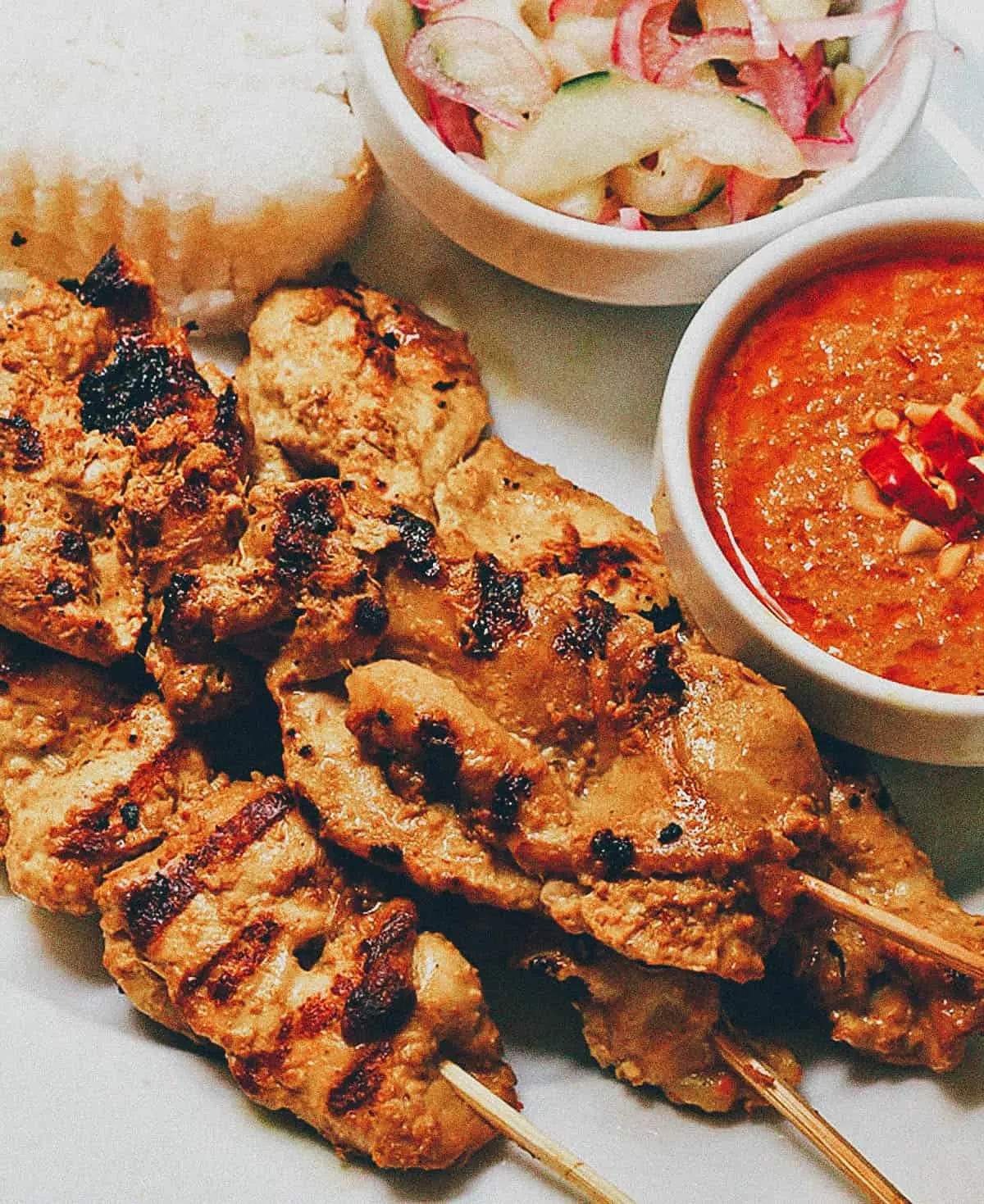
Disclosure
This recipe for chicken satay contains affiliate links which will earn us a small commission if you make a purchase at no additional cost to you. We really appreciate your support as it helps us share more of these free recipes. Thank you!


Erix
Wednesday 15th of April 2020
I believe sate originated from China not Arab
JB & Renée
Friday 24th of April 2020
Thanks Erix. Can you send me a link with that information? Would love to read it.
Carlos
Friday 1st of February 2019
Ive tasted sate in numerous countries. To be quite honest. The best ones can be found in indonesia. Sure not all vendors offer the best quality. But in general the sate in indonesia is superior to singaporean and malaysian sate. The peanut sauce suits my pallet best. The meat on the skewer thinz which makes the sate more tender ans juicy. The sambal is better, like most sambal is from indonesia. The rice cake is made in leaves instead of plastic. Anyways yaah, nice article!!
JB & Renée
Saturday 2nd of February 2019
Happy to hear that Carlos! Sate is pretty awesome, one of the best accompaniment to beer I think. So smokey and delicious, and easy to eat too. :)